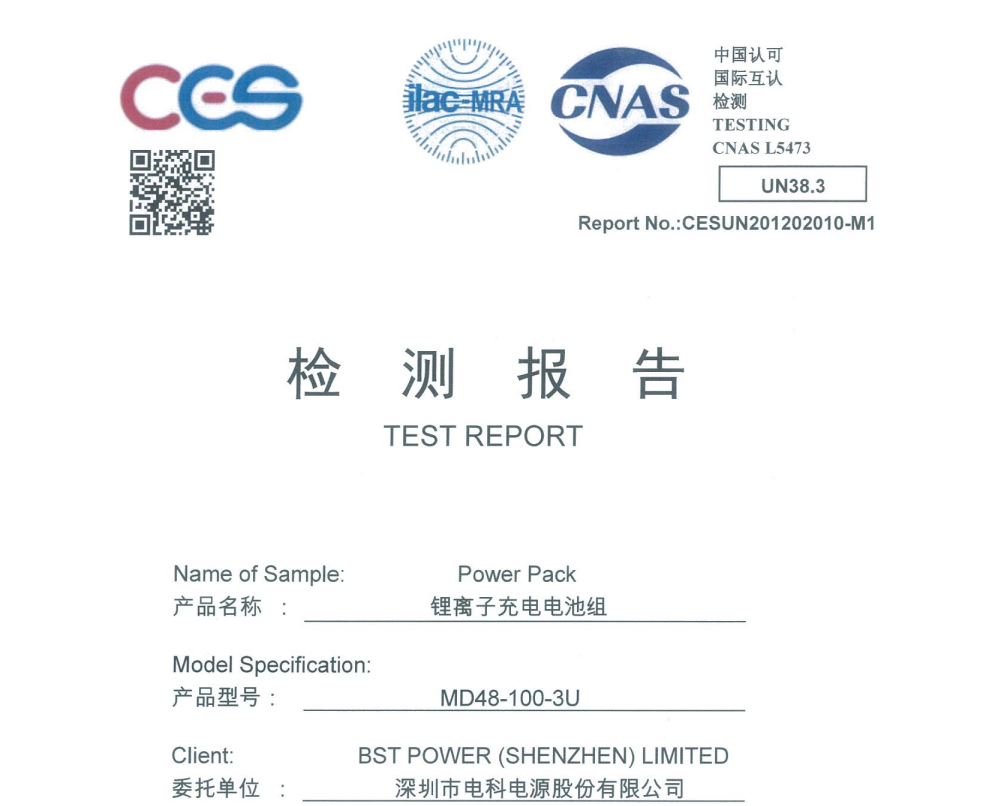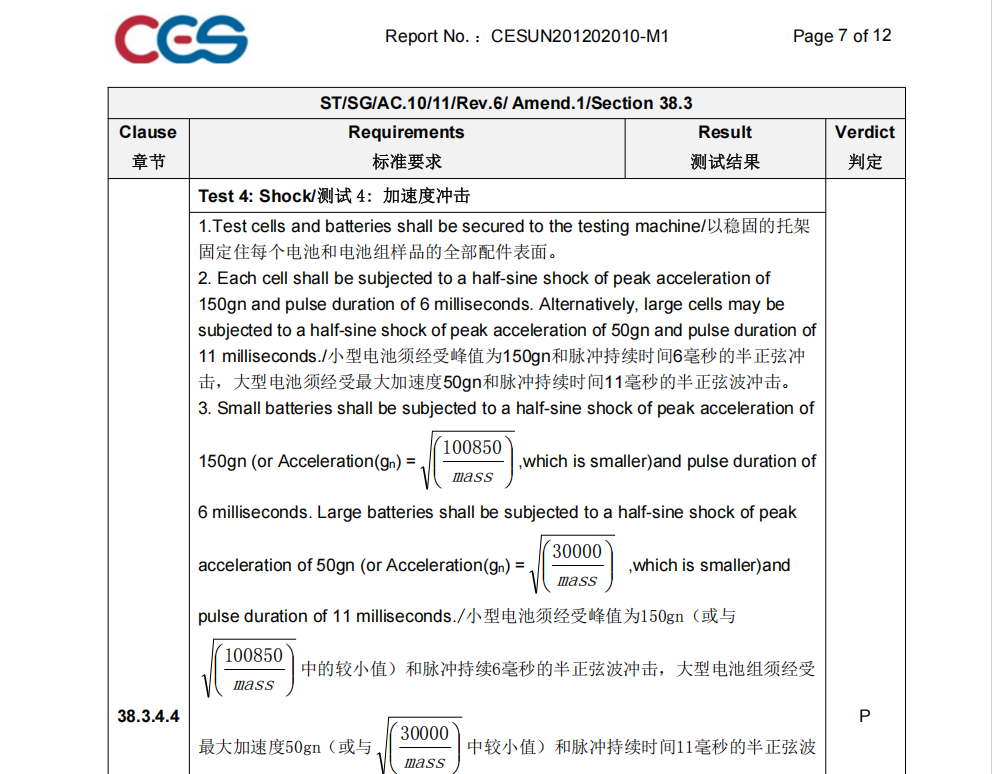Introduction
UN38.3 is a critical international safety standard in the transportation of lithium batteries. The United Nations developed it to regulate the safe handling, packaging, and shipment of lithium-ion and lithium-metal batteries, classified as hazardous materials due to their potential risks of fire, explosion, or leakage.

Why should customers know about UN38.3?
- Safety Compliance: Customers dealing with lithium batteries, whether for personal or commercial purposes, must ensure their products meet this certification to avoid logistical setbacks.
- Legal Obligation: Without UN38.3 certification, shipments may be rejected by carriers, delayed at customs, or penalized by regulatory authorities.
- Global Relevance: It applies to all types of transportation (air, sea, and land) and is recognized worldwide, making it indispensable for cross-border trade.
- Market Trust: UN38.3 certification reflects a manufacturer’s commitment to product safety and quality, boosting credibility in a competitive market.
For manufacturers, understanding and complying with UN38.3 is a formality and a cornerstone for building trust with clients and navigating the complexities of international shipping regulations.
Definition and Background
What is UN38.3?
UN38.3 is a section within the United Nations Manual of Tests and Criteria. It specifically addresses the safe transportation of lithium batteries, requiring them to undergo a series of stress tests to prove they can withstand the rigors of transport without posing safety hazards.
Scope of Application:
- Standalone lithium batteries (e.g., power banks, cylindrical cells).
- Batteries installed in equipment (e.g., smartphones, laptops).
- Batteries packaged alongside equipment (e.g., backup batteries shipped with solar panels).
Why was it introduced?
Lithium batteries are classified as “Class 9 dangerous goods” due to their ability to store and release large amounts of energy. Early incidents, such as batteries igniting during air transport, highlighted the need for standardized safety measures. UN38.3 was introduced to address these concerns and ensure a universal standard for manufacturers and logistics companies.
Historical Development:
The regulation has evolved significantly since its inception. Initial standards focused on basic safety, while updates introduced rigorous testing protocols to match advancements in battery technology. Recent amendments now address specific chemistries, such as lithium iron phosphate (LiFePO4), to reflect their growing market share.
UN38.3 Testing Standards
To ensure the safe transportation of batteries, UN38.3 mandates eight tests that simulate real-world conditions during shipment. These tests are designed to identify potential safety issues before batteries reach consumers.
1. Altitude Simulation:
- Purpose: Mimics low-pressure conditions at high altitudes (e.g., during air transport).
- Process: Batteries are stored at a pressure of 11.6 kPa for six hours.
- Expected Outcome: No leakage, venting, rupture, or fire.
2. Thermal Test:
- Purpose: Test the battery’s resistance to extreme temperature fluctuations.
- Process: Batteries undergo rapid temperature changes, cycling between -40°C and 75°C for 10 cycles.
- Importance: Ensures durability during transport through regions with varying climates.
3. Vibration Test:
- Purpose: Simulates vibrations experienced during transportation (e.g., on trucks, ships, or planes).
- Process: Batteries are subjected to vibrations between 7Hz and 200Hz for three hours.
- Expected Outcome: No structural damage, leakage, or fire.
4. Shock Test:
- Purpose: Assesses how batteries react to sudden physical impacts.
- Process: Batteries are subjected to a force of 150g over a short duration.
- Significance: Ensures the battery can withstand accidental drops or collisions.
5. External Short Circuit Test:
- Purpose: Tests the safety of batteries when their terminals are short-circuited.
- Process: Batteries are exposed to a high current for one hour under controlled conditions.
- Expected Outcome: No fire or explosion.
6. Impact Test:
- Purpose: Simulates heavy objects falling on the battery.
- Process: A steel rod is dropped from a specific height onto the battery.
- Outcome: Batteries must not catch fire, rupture, or vent.
7. Overcharge Test:
- Purpose: Assesses the battery’s ability to handle excessive charging currents.
- Process: Batteries are charged at twice their recommended voltage.
- Outcome: Prevents overcharging failures.
8. Forced Discharge Test:
- Purpose: Tests how batteries behave when discharged in extreme conditions.
- Process: Batteries are forced to discharge to test their thermal stability.
- Importance: Ensures batteries do not overheat or explode.
Importance of UN38.3
Why is it indispensable?
- Global Transport Compliance: UN38.3 certification is mandatory for shipping batteries internationally, especially for air freight, which has strict safety regulations.
- Safety Assurance: Prevents accidents during transit, such as fires or explosions caused by defective batteries.
- Customs Clearance: Batteries without certification are likely to be held up at customs, incurring delays and financial losses.
- Brand Reputation: Compliance signals a manufacturer’s dedication to product safety, which is crucial for customer trust and market competitiveness.
Certification Process
Step-by-Step Process:
- Preparation: Submit product specifications, including design, chemistry, and capacity details.
- Lab Testing: Certified testing facilities perform the eight UN38.3 tests.
- Evaluation: Test results are reviewed for compliance with UN38.3 criteria.
- Certification Issuance: Successful products receive an official UN38.3 report, which includes detailed documentation for customs and carriers.
Timeframe:
Testing typically takes 2-4 weeks but may vary based on battery size and complexity.
Costs:
Costs range from $2,000 to $10,000 depending on the battery type and the testing facility.
Tips for Manufacturers:
- Collaborate with experienced certification labs.
- Prototype testing can identify potential issues early.
- Keep detailed documentation to expedite the process.
Industry Trends and Insights
Emerging Concerns (Based on Google Data):
- Faster Certification: Companies want to minimize testing time to accelerate market entry.
- Cost Reduction: Manufacturers seek ways to reduce testing expenses without compromising quality.
- Adaptation to Regional Standards: While UN38.3 is global, certain regions impose additional requirements, adding complexity to the process.
Future Trends:
- New tests for next-generation batteries (e.g., solid-state and sodium-ion).
- Automation in certification processes to streamline testing and reduce human error.
Frequently Asked Questions (FAQ)
1. Which batteries need UN38.3 testing?
All lithium-ion and lithium-metal batteries, regardless of size or capacity, require testing.
2. What happens if my battery lacks certification?
Non-certified batteries face rejection by carriers, legal penalties, or even recalls.
3. How can manufacturers meet UN38.3 requirements during product design?
Incorporate safety mechanisms (e.g., overcharge protection) during the development phase.

Conclusion
UN38.3 plays a pivotal role in the global transportation of lithium batteries, ensuring safety and compliance in a rapidly growing market. For manufacturers, aligning product development with UN38.3 standards is essential for success in international trade. As battery technology evolves, adherence to these regulations will remain critical to safeguarding logistics, end-users, and the industry as a whole.



